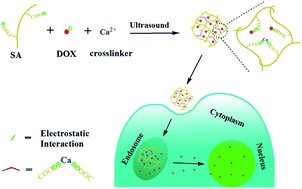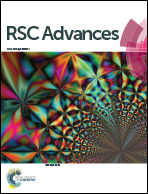A green and facile method for the preparation of a pH-responsive alginate nanogel for subcellular delivery of doxorubicin
Abstract
A surfactant-free and organic solvent-free one-pot method was utilized for the preparation of a pH-responsive alginate nanogel (pH-AN). Simply by mixing anionic sodium alginate (SA) with cationic doxorubicin (DOX) through electrostatic interactions, followed by in situ crosslinking with ionic calcium under ultrasound, a DOX-loaded pH-AN was obtained. The sizes of the nanogels can be tailored by varying the concentration of SA, the ratio of SA to ionic calcium and DOX. The nanogel was measured with a size range of 210 nm, and a polydispersity index of 0.208, as confirmed by transmission electron microscopy and dynamic light scattering. In vitro release profiles showed a significantly higher accumulative release at pH 5.0 than at pH 7.4, exhibiting apparent acid responsiveness. In vitro cytotoxicity tests clearly illustrated the remarkable inhibition to the growth of HeLa cells with an IC50 value of 0.26 μg mL−1. In contrast, NIH 3T3 cells displayed high tolerance. The plain nanogel exclusive of DOX was practically non-toxic. Confocal laser scanning microscopy observation demonstrated that DOX was efficiently internalized into HeLa cells through endocytosis, released into the cytoplasm, and then principally entered the nuclei. It is clearly suggested that a green and facile method was proposed to achieve a pH-responsive nanogel carrier for the delivery of drugs.


 Please wait while we load your content...
Please wait while we load your content...